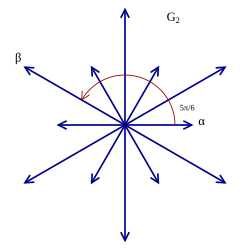Hexagram
A hexagram is a six-pointed star, with all lines the same length and all angles the same. A 'hexangle', 'star hexagon', or 'hexalpha' means the same thing.[1] It is used in historical, religious and cultural contexts, for example in Hanafism,[2] Judaism, Hinduism and occultism. It is possible that this simple geometric shape, like the triangle, circle, or square, has been created by various peoples with no connection to one another.
Group theory
In mathematics, the root system for the simple Lie group G2 is in the form of a hexagram, with six long roots and six short roots.
Construction by compass and a straight edge
A six-pointed star, like a regular hexagon, can be created using a compass and a straight edge:
- Make a circle of any size with the compass.
- Without changing the radius of the compass, set its pivot on the circle's circumference, and find one of the two points where a new circle would intersect the first circle.
- With the pivot on the last point found, similarly find a third point on the circumference, and repeat until six such points have been marked.
- With a straight edge, join alternate points on the circumference to form two overlapping equilateral triangles.
Hexagram Media
A regular hexagram, {6}[2{3}]{6}, can be seen as a compound composed of an upwards (blue here) and downwards (pink) facing equilateral triangle, with their intersection as a regular hexagon (in green).
The Star of David in the oldest surviving complete copy of the Masoretic Text, the Leningrad Codex, dated 1008.
Star of David on the Salt Lake Assembly Hall
Mon emblem of the Kagome clan.
References
- ↑ Graham, Dr. O.J. 2001. The Six-Pointed Star: its origin and usage. 4th ed, Toronto: The Free Press, . ISBN 0-9689383-0-2
- ↑ Miller, Sam 2010. Delhi: Adventures in a Megacity, page 91.









